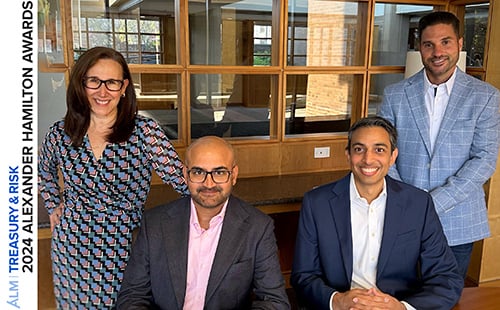
Geopolitical and economic turmoil is fueling global credit market disruptions and triggering a broadening view of portfolio risk exposure among corporate treasurers.
The confluence of complex financial marketplace dynamics has accelerated tightening of the credit markets. The first of these dynamics is inflation. Borrowers and lenders are taking a more cautious outlook on financial management as macro challenges emerge due to the inflationary pressures.
Recommended For You
Central banks worldwide are raising rates in direct response to inflationary stress, to preserve market integrity and support recovery stability in the post-pandemic environment. According to The New York Times, in a business article that appeared on July 18, 2022, "at least 75 central banks lifted interest rates this year." The aggressive increases throughout 2022 have led to a global phenomenon of more expensive credit and higher default risk.
At the same time, this summer's high inflation demonstrated the credit markets' heightened sensitivity to unpredictable economic conditions. Inflation has been tracking at the fastest pace in more than two decades. Revenue generators are currently driving portfolio business models in search of investments with lower volatility. And the drastic movement of mature economies away from the historically low interest rate environment of recent years underscores the significance of broader loan portfolio diversification. The risk profile of bank and corporate asset portfolios has never been more important in a world dealing simultaneously with recessionary and inflationary fears.
Despite these challenging headwinds, however, companies are still exhibiting ample demand for credit. Volume is driven by sector. For example, global energy markets are under scrutiny in the wake of disproportionate levels of demand and supply, thereby inflicting volatility. Yet the energy sector is experiencing renewed volume in some regions, as corporate borrowers seek access to favorable credit and new deal opportunities. International banks have deep capacity to meet that demand for clients equipped to satisfy payment of higher-interest loans.
Greater attention is being focused on those investments within low cyclical sectors, such as healthcare, or organizations with the ability to pass on cost increases through business services. Of note, favorable demographics and non-cyclical end-market demand make some healthcare sectors particularly interesting.
Who's Most Impacted by Global Monetary Policy
As global monetary policy tightens, the threat of default grows for those companies that are highly leveraged and/or subject to near-term refinancing requirements. Interest rate hikes are causing a reversal in the flow of funds that companies have enjoyed in recent years. This is creating an adverse chain reaction, which is drying up liquidity in international finance markets.
Vulnerable countries are facing currency devaluation, thereby worsening domestic demand for loans and leading to negative credit growth. Banks that depend heavily on foreign funding are suffering from balance sheet disparity linked to the strong dollar. In some countries, this is resulting in at-par market currency rates.
Emerging markets are confronting a wall of issues, not the least of which is the continued strength of the U.S. dollar. The value of the U.S. dollar has been driven upward by inflationary pressures and rate hikes in markets worldwide. It is now at a 20-year high, gaining more than 10 percent this year.
Credit market challenges in the aftermath of the global pandemic have had the most severe effect on emerging markets, leading to stagnation of the supply of essential goods and a lingering inability to manufacture consumer goods for export.
Alternative Business Approaches to Manage Credit Risk
The global debt markets face increased risk of defaults as more and more companies have to refinance existing loans within a rising-rate economy. For corporate treasury teams, this means re-evaluating their risk management profile to reduce their exposure to risky customer accounts. One option to mitigate these risks, credit insurance, is on the rise.
Credit insurance offers an approach that might enable a company to extend credit commitments, by providing hedging against the risk of customer payment default. Often referred to as "accounts receivable" or "failure to pay" insurance, credit insurance programs can be structured to protect valid and enforceable debt obligations against the risk of nonpayment. Coverage options can apply to a single debtor that owes money to the company, or as a more encompassing portfolio approach. These programs are underwritten to manage portfolio assets by sharing a percentage of the default risk with the insurer. Credit insurance offers an alternative balance sheet financing strategy for banks, multilateral financial institutions, global commodity firms and exporters, and multinational corporates.
Emergence of Strategic Risk Transfer Strategies
Credit markets are striving to navigate capital requirements within regulatory parameters but are faced with economic challenges. Corporates are looking to bring to market a wide distribution of risk within a diversified portfolio of loans. A broadening view of risk has evolved into a fresh look at what companies can deploy in terms of capital allocation strategies.
Strategic risk transfer (SRT) strategies have emerged as a promising approach, although this is still an evolving business model. SRT transactions are designed to ease overall nonpayment exposure on a range of assets and lessen capital allocation prerequisites for more efficient, profitable portfolio risk management.
SRT is, in essence, a transactional structure that de-risks loan portfolio exposure by transferring the risk of aggregate borrower nonpayment to a third party. SRT deals can involve corporate loan assets such as trade finance loans, loans to small and midsize enterprises, infrastructure and project finance loans, or mortgage loans, among other classes. SRT strategies can be executed on a funded basis via note purchase by specialist credit firms dedicated to the SRT arena and/or on an unfunded basis via nonpayment insurance coverage offered by various credit insurance market carriers.
Given today's monetary climate, credit markets are leaning toward reduced demand for riskier assets and liquidity in high-risk bonds or longer-term assets that are diminishing.
Myriad economic and geopolitical variables driving volatility across all industry sectors now require business model investment strategies that embrace today's irreversible shifts for sustainable risk management soundness.
 Ranjini Pillay is senior vice president of the Credit Division at Crum & Forster. Pillay's professional career spans more than 30 years. Her expertise focuses on specialty business lines to open new markets and develop innovative insurance programs outside the traditional property and casualty markets.
Ranjini Pillay is senior vice president of the Credit Division at Crum & Forster. Pillay's professional career spans more than 30 years. Her expertise focuses on specialty business lines to open new markets and develop innovative insurance programs outside the traditional property and casualty markets.
 Andrew Shapiro is the COO of Applied Risk Capital LLC, which he founded in 2019 to originate and underwrite nonpayment insurance, primarily for non–investment-grade leveraged loans and derivatives. He has extensive credit experience over a 30-year banking career.
Andrew Shapiro is the COO of Applied Risk Capital LLC, which he founded in 2019 to originate and underwrite nonpayment insurance, primarily for non–investment-grade leveraged loans and derivatives. He has extensive credit experience over a 30-year banking career.
© Touchpoint Markets, All Rights Reserved. Request academic re-use from www.copyright.com. All other uses, submit a request to [email protected]. For more inforrmation visit Asset & Logo Licensing.



